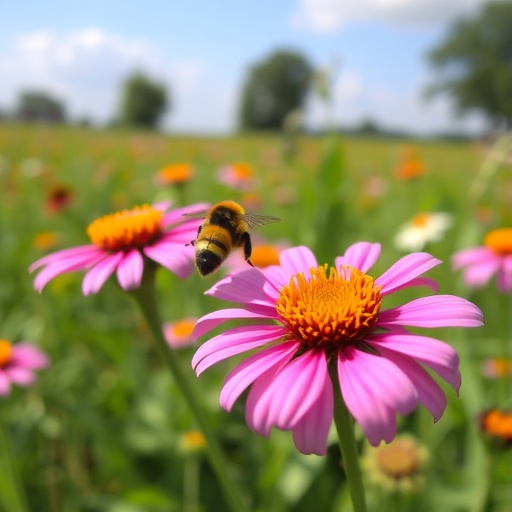In the sprawling 170-acre wild blueberry fields of Maine, where landscape and climate intertwine in complex ways, a pioneering study is shedding light on how the subtle variations in microclimate profoundly influence pollinator behavior and crop productivity. Conducted by a collaborative team from Penn State, the University of Pittsburgh, and Wyman’s—the nation’s largest wild blueberry producer—this research uncovers critical insights into the role of small-scale climate dynamics within agricultural systems, a domain often overlooked in the broader context of climate change and ecological studies.
The investigation focused on microclimates, defined as the climate conditions specific to a confined or localized area that can differ markedly from broader regional climates. These microclimates, often influenced by minute topographic, vegetative, and atmospheric variables, have now been shown to play a decisive role in regulating the activity patterns of both wild and managed pollinators. Using an innovative sensor network, researchers meticulously measured temperature and humidity every ten minutes across 120 one-square-meter plots within the blueberry field during bloom, producing a granular environmental dataset that illuminated spatial variability with remarkable precision.
One of the groundbreaking findings from this study was that both wild bees and honey bees preferentially foraged in areas of the field with the highest flower densities. Intriguingly, wild bees demonstrated a distinct preference for warmer microclimates, venturing earlier in the day and exploiting a broader range of environmental conditions compared to their managed counterparts. Contrary to concerns about competition, the researchers noted that wild bee abundance remained stable even in proximity to honey bee hives and in zones of intensive honey bee foraging, dispelling assumptions of direct competitive displacement in these microhabitats.
The spatial heterogeneity observed within the blueberry fields was striking; microclimatic variations of up to 10 degrees Celsius in temperature and 29% relative humidity created a mosaic of environmental niches. This fine-scale variability had tangible effects on both pollinator distributions and pollination success, underscoring the importance of considering microclimate fluctuations when evaluating agricultural ecology. Notably, warmer areas of the field coincided with denser flower blooms and significantly higher blueberry yields, establishing a clear linkage between microclimate, pollinator foraging intensity, and crop productivity.
This research offers a fresh perspective on precision agriculture, advocating for the integration of microclimatic monitoring into farm management practices. Heather Grab, the study’s lead author and an assistant professor at Penn State’s College of Agricultural Sciences, emphasizes that remote sensing technologies capable of mapping flower density and microclimate variables could enable farmers to identify underperforming zones ripe for conversion into pollinator-friendly conservation habitats. Such targeted interventions could simultaneously enhance biodiversity and optimize agricultural output, fostering resilient agroecosystems in the face of climatic uncertainties.
The implications of this work resonate profoundly amid global pollinator declines, which threaten food security and ecosystem services worldwide. While large-scale factors such as climate change, habitat loss, and floral resource availability are known drivers of pollinator reductions, this study highlights how within-field microclimatic nuances exert additional, significant influence on pollinator activity and diversity. This insight calls for a paradigm shift, encouraging researchers and practitioners alike to adopt finer spatial and temporal scales when examining pollination dynamics.
Beyond direct agricultural impacts, the study exemplifies the power of interdisciplinary collaboration. Integrating expertise across entomology, civil and environmental engineering, and agricultural sciences, the team developed sophisticated modeling frameworks that could track microclimate changes and their biological ramifications with unprecedented resolution. Co-author Vikas Khanna underscores the necessity of such integrative approaches, especially when addressing the multi-dimensional challenges posed by climate change on farming systems.
The involvement of undergraduate and graduate students from the University of Pittsburgh was critical to the deployment and maintenance of the dense sensor array, which generated an extensive dataset documenting environmental conditions and pollinator behavior throughout the bloom period. This hands-on data collection enabled the researchers to correlate the spatial distribution of honey bee hives, flower counts, pollinator visitation rates, and eventual fruit set on a plot-by-plot basis, illuminating mechanisms that underlie yield variability.
Research findings demonstrate that managing microclimatic heterogeneity could be key to stabilizing fruit production. Since warmer microclimates support more prolific flowering and attract pollinators more effectively, climate-induced alterations in microclimate variability could amplify yield fluctuations within fields. Understanding these dynamics may empower agricultural managers to adapt practices, potentially adjusting vineyard microenvironments or pollinator provisioning to buffer against adverse climate impacts.
Another remarkable aspect of the study is the lack of observed negative interactions between wild and managed bees in the field. This suggests that carefully managed apiary placement could mitigate concerns about hive density adversely impacting wild pollinator populations—a vital consideration as efforts intensify to maximize pollination services sustainably. The nuances uncovered here provide a hopeful narrative in which wild and managed pollinators coexist and collectively enhance crop yields.
Looking forward, the researchers advocate for extending this line of inquiry across different geographic regions and multiple growing seasons to validate and expand upon these insights. Such longitudinal and spatially diverse investigations are essential to account for interannual climatic variability and land-use differences that may influence microclimate-pollinator-plant interactions. This continued effort promises to refine our understanding of complex agroecological systems and inform adaptive management strategies under changing environmental conditions.
Ultimately, this study reveals that agricultural landscapes are a tapestry of microclimates that orchestrate the behavior of pollinators and the fate of crops with exquisite subtlety. As climate change accelerates, unraveling these fine-scale environmental threads becomes imperative to maintaining resilient food systems and conserving the vital pollinator species upon which humanity depends.
Subject of Research: Animals
Article Title: Unraveling microclimate effects on pollinator foraging and crop yield in lowbush blueberry
News Publication Date: 17-May-2025
Web References:
https://www.sciencedirect.com/science/article/pii/S016788092500266X
http://dx.doi.org/10.1016/j.agee.2025.109734
References:
Grab, H., Khanna, V., Grozinger, C., Sisk, G., Ostroski, A., Dillard, T., Hall, B., Goslee, S. "Unraveling microclimate effects on pollinator foraging and crop yield in lowbush blueberry." Agriculture, Ecosystems & Environment, October 2025.
Keywords:
Horticulture, Pollination Ecology, Microclimate, Precision Agriculture, Crop Yield Variability, Wild Bees, Honey Bees, Climate Change, Environmental Sensors




